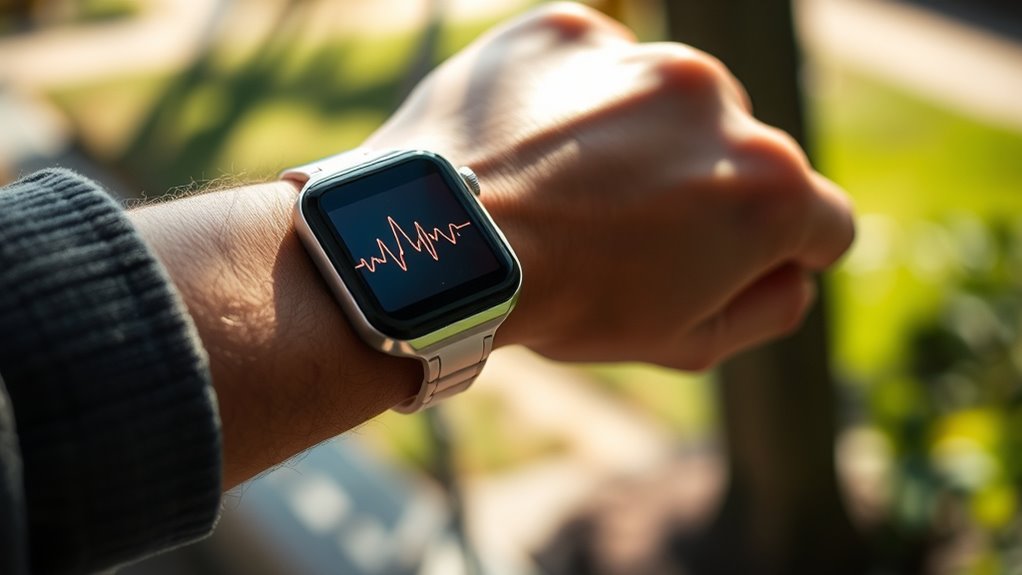Heart rate variability (HRV) shows how your nervous system responds to stress and relaxation, acting as a window into your mind-body connection. When your HRV is high, it indicates a balanced autonomic nervous system capable of handling daily challenges. Low HRV suggests your body is under stress or struggling to recover. By monitoring HRV, you can better understand this connection and improve your resilience through simple practices. Keep going to discover how you can use HRV to boost your well-being.
Key Takeaways
- HRV reflects the dynamic balance between the sympathetic and parasympathetic nervous systems, illustrating the mind-body connection.
- Fluctuations in HRV indicate how mental states like stress or relaxation directly impact physiological responses.
- Improving HRV through relaxation techniques enhances both mental resilience and physical health, strengthening the mind-body link.
- HRV serves as a real-time indicator of nervous system health, revealing how emotional and physical health are interconnected.
- Monitoring HRV enables proactive management of stress, supporting overall well-being and reinforcing the mind-body relationship.

Heart rate variability (HRV) refers to the subtle fluctuations in the time between your heartbeats, reflecting how your nervous system responds to stress and relaxation. When you pay attention to HRV, you’re essentially tapping into your body’s autonomic regulation—your body’s way of maintaining balance between the sympathetic and parasympathetic nervous systems. This balance influences how well you handle stress and recover from it, making HRV a valuable indicator of your stress resilience. A higher HRV typically signals that your body can adapt smoothly to changing circumstances, while a lower HRV might suggest you’re under strain or less capable of managing stress effectively.
Understanding HRV gives you insight into your autonomic regulation at a deeper level. Your autonomic nervous system controls involuntary functions such as heart rate, digestion, and breathing. When your sympathetic nervous system is dominant, your heart rate increases, preparing you for “fight or flight.” Conversely, when your parasympathetic nervous system takes the lead, your heart rate slows, promoting relaxation and recovery. HRV reflects this tug-of-war, serving as a real-time barometer of how well your nervous system is functioning. If your HRV is consistently low, it may indicate that your body is stuck in a stress response, making it harder for you to recover from daily pressures.
Monitoring your HRV can help you develop better stress resilience. When you recognize patterns of low HRV, you can take steps to implement relaxation techniques like deep breathing, meditation, or mindful activity to boost your parasympathetic response. Regularly practicing these techniques can enhance your autonomic regulation, allowing your body to bounce back more quickly from stressors. Over time, this increased resilience not only improves your mental well-being but also supports physical health, reducing risks associated with chronic stress such as hypertension and inflammation.
Monitoring HRV helps build resilience through relaxation techniques, improving mental and physical health over time.
In principle, HRV acts as a window into how your mind and body are interconnected. By understanding and improving your HRV, you’re empowering yourself to better manage stress, enhance recovery, and foster a more resilient nervous system. Whether you’re looking to optimize athletic performance, improve mental clarity, or simply feel more balanced, paying attention to your HRV gives you a practical tool to tune into your body’s natural rhythms. Recognizing the importance of autonomic regulation and stress resilience through HRV enables you to take proactive steps toward better health, resilience, and overall well-being.
Frequently Asked Questions
How Does HRV Change With Age?
As you age, your HRV generally declines due to developmental changes and an age-related decline in autonomic nervous system flexibility. You might notice reduced variability, indicating less adaptability to stress and recovery. This change reflects how your body’s ability to respond to environmental and internal stimuli diminishes over time. Maintaining a healthy lifestyle can help mitigate some of these effects, supporting better heart health and overall resilience as you age.
Can HRV Predict Future Health Conditions?
Oh, sure, HRV’s crystal ball status is undeniable—who needs fortune-tellers? You might think it predicts future health conditions, but it’s more like a stress marker indicator with a side of meditation benefits. While a higher HRV suggests resilience, a low one warns you about potential issues. Keep an eye on your HRV, because it can help you spot trouble early and embrace calming practices before disaster strikes.
What Lifestyle Factors Most Influence HRV?
You can influence your HRV most through lifestyle factors like stress management and sleep quality. Managing stress by practicing mindfulness or relaxation techniques helps stabilize your nervous system, boosting HRV. Prioritizing good sleep, with consistent routines and quality rest, also enhances your heart rate variability. These changes support better autonomic balance, leading to improved overall health and resilience.
Is HRV Measurement Suitable for Children?
Imagine a gentle river flowing steadily—this is what HRV offers in understanding children’s well-being. Measuring HRV can be appropriate for children, as it reflects pediatric stress and child development stages. You can observe how their nervous system responds to daily challenges, providing insights into emotional regulation and resilience. Just remember, proper techniques guarantee accurate readings, making HRV a valuable tool to support their growth and health.
How Quickly Can HRV Improve With Intervention?
You might wonder how quickly HRV can improve with intervention. Generally, you could see changes within a few days to weeks, especially if you consistently practice breathing techniques or meditation. These activities help activate your parasympathetic nervous system, increasing HRV. Regular practice enhances your mind-body connection over time, leading to more noticeable improvements in your HRV, energy levels, and overall well-being.
Conclusion
Understanding heart rate variability shows you how your mind and body truly connect. By paying attention to these tiny changes, you can better manage stress, boost your well-being, and stay balanced. Isn’t it amazing that something as simple as your heartbeat can reveal so much about your health? So, why not start listening to your heart today and reveal the secrets of your mind-body connection? Your journey to wellness begins with awareness.










